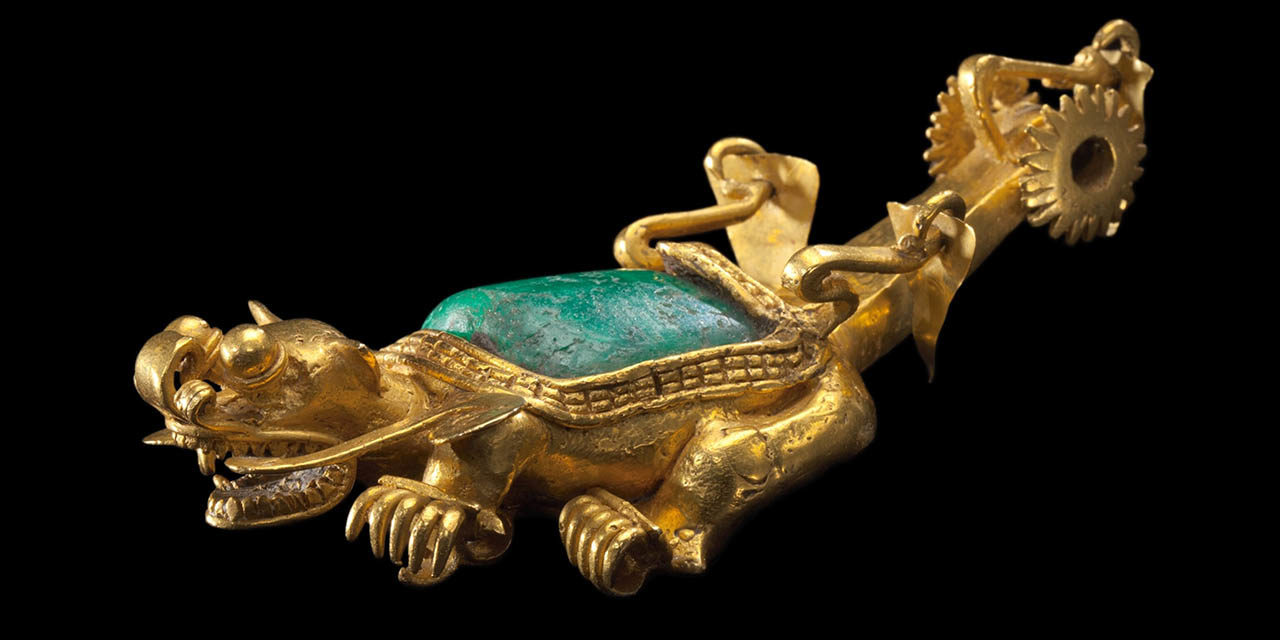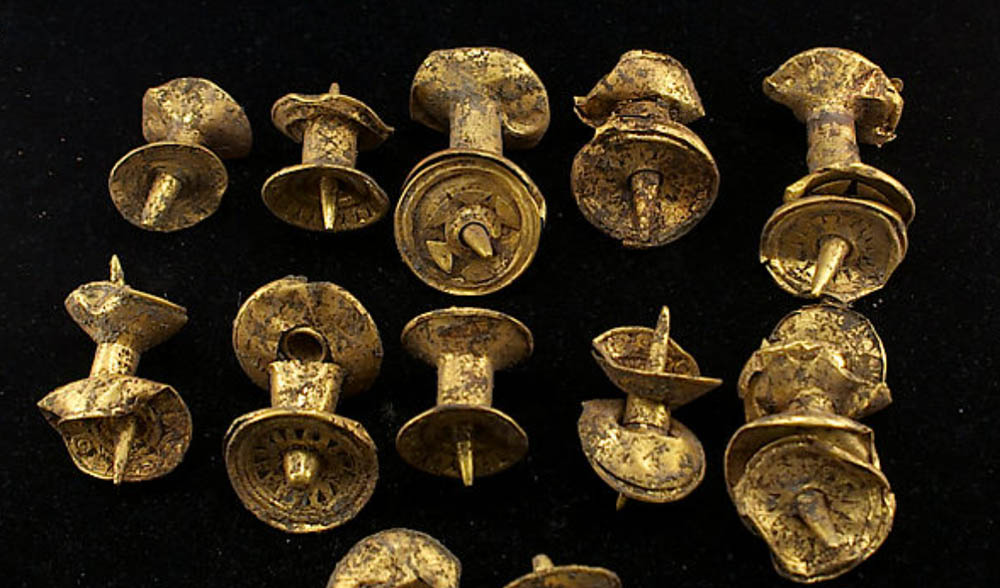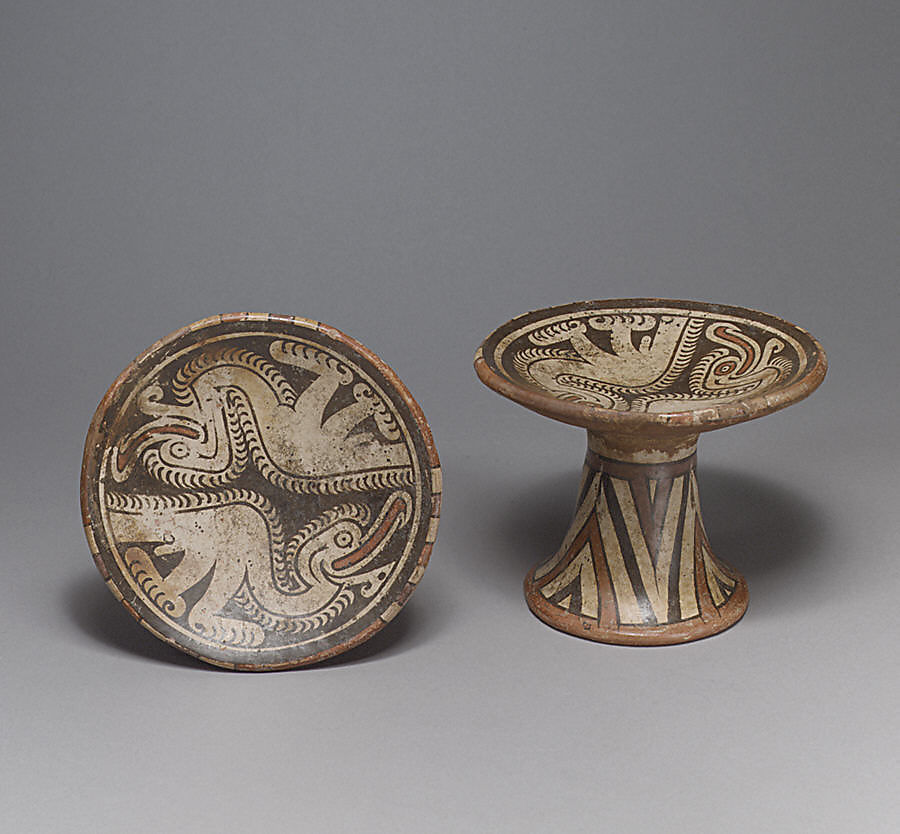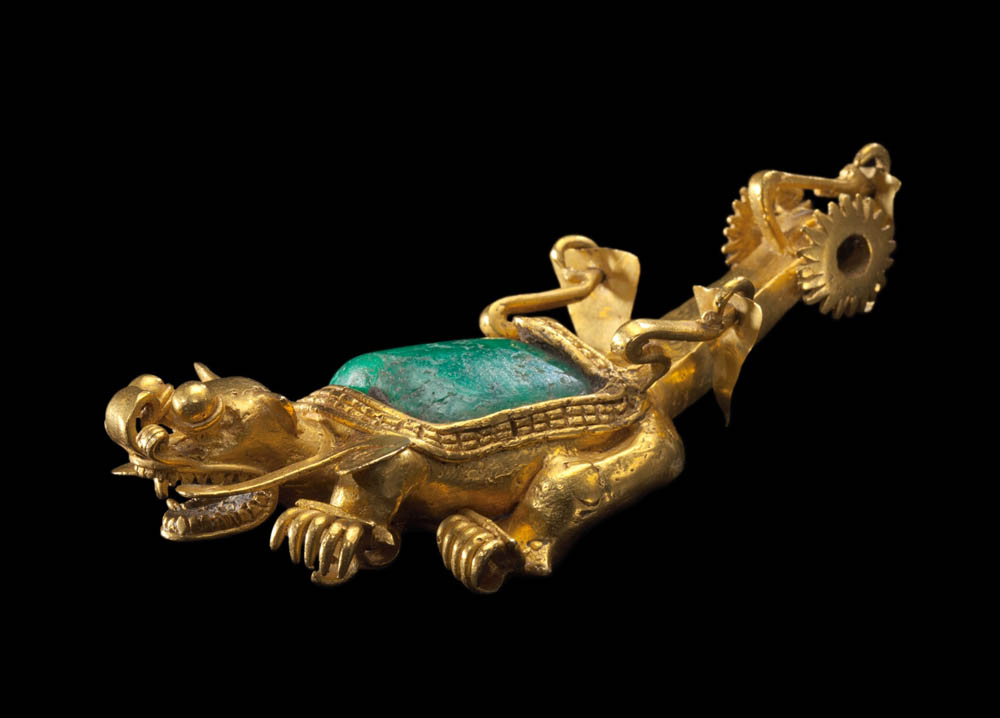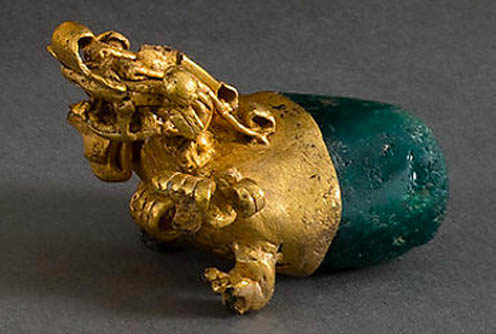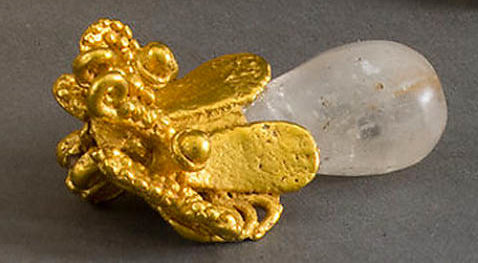Between the fifth century and tenth century, the Coclé people inhabited an archaeological area in Central America known as Gran Coclé, which coincides with the modern-day Panamanian province of Coclé. A remarkable necropolis titled Sitio Conte there contains many precious objects that express social status, political power, and religious beliefs, while also demonstrating expert metal-smithing in the luxurious ornamentation of rulers and depictions of gods.
THE DISCOVERY OF THE NECROPOLIS
Powerful leaders of the Coclé culture were buried in this cemetery located in the Río Grande valley, near the Gulf of Parita, in Panama (The Met 2018). During the early 20th century, the owners of the land, the Conte family, observed the shifting course of the Río Grande de Coclé due to heavy rains. As a new channel was cut into the flat coastal plain due to successive floods, ancient burials were becoming exposed on the river’s edge, and pieces of gold and pottery were washed into the river. In 1940, the University of Pennsylvania’s Museum of Archaeology and Anthropology excavated the now world-renowned Sitio Conte, and discovered archaeological evidence of a large cemetery (Penn Museum 2018). The discovery of Sitio Conte, and its subsequent excavation, has provided evidence of the importance of gold and other precious materials in the dress and funerary practices of the Coclé, as well as the scale and creativity of the culture’s metalworking practices and traditions.
Dozens of rulers, warriors, and attendants were uncovered from the necropolis, found interred with a plethora of objects and sometimes adorned with luxurious ornaments made from sheet gold, shells, bone, and gemstones (The Met 2018). Based on Spanish records recovered from the sixteenth century, archaeologists and historians learned that the burial practices observed at Sitio Conte were reserved for chiefs and nobility, while the bodies of the common people were laid to rest and honored in more modest ways. The bodies of non-elites were sometimes transported to a deserted spot and abandoned, while some were laid to rest in humble, though complex burials, accompanied by carefully arranged funerary offerings such as bundles of cloth and stone tools. However, favorite wives and retainers often accompanied their masters into the grave. The graves of Sitio Conte were often superimposed one over another, the longest sequence consisting of eight separate burials. While more recent graves contained a single body, in a flexed position, accompanied by meager funeral offerings, graves of an earlier period were greater in size. Burials that occured prior to the Spanish conquest often contained two bodies, buried in an extended position facing downward, with their head to the northeast. Jewelry made out of stone, bone, copper or gold was often placed alongside the dead, in addition to 30 to 40 pottery vessels, tools, weapons and fabrics (Lothrop 1934, 207-209).
The most ancient graves of the necropolis are also some of the largest, measuring up to twelve feet on one side. The floor of the grave was flattened and rectangular in shape, topped with one or more fire-marked stone slabs upon which the inhabitant of the grave was placed. In addition to the main occupants of the graves, the dead were accompanied by three to over twenty others, sometimes piled on top of eachother (Lothrop 1934, 209). In the most ancient graves, funeral furnishings were offered in such large quantities that they would completely roof over the dead. These burials would usually contain at least 200 pottery vessels, including plates, bowls, carafes, bottles and jars, in addition to various types of weapons and tools (Lothrop 1934, 210). Most importantly, almost all of the bodies resting in these large graves were decorated with lavish articles of personal adornment, with special attention paid to the principal occupant.
WHAT ARCHAELOGISTS UNCOVERED
The archaelogists described what they found in an article in the American Journal of Archaelogy (1934):
“necklaces of bone, animal teeth or of gold, headbands of gold, cuffs and greaves of gold, nose rings of stone or gold, golden spools for insertion in the ear lobes, and long sticks of gold or of stone tipped with gold for the same purpose.” (Lothrop 210)
Figure 1 features an image of one half of a Coclé ear spool, while figure 2 depicts a group of complete Coclé ear spools found together. The ear spool in figure 1 is constructed out of six joined pieces of hammered metal sheet through a crimping technique, and features a geometric design. As the Met explains, this piece of jewelry would have been worn by separating the two halves of the ear spool, passing the cylindrical ends through the earlobe, and then rejoining the two halves.
Fig. 1 – Maker unknown (Coclé). Half of an ear spool, A.D. 450-1000. Gold. New York: Metropolitan Museum of Art, 1979.206.484a,b. The Michael C. Rockefeller Memorial Collection, Bequest of Nelson A. Rockefeller, 1979. Source: The Met
Fig. 2 – Maker unknown (Coclé). Group of ear spools found together in Operation 1, Tomb 6, Unit 125 at El Caño, A.D. 450-1000. Gold. New York: Metropolitan Museum of Art, 1979.206.484a,b. Registration #7621. Photograph by Julia Mayo. Source: The Met
Fig. 3 – Maker unknown (Coclé). Ear rods, A.D. 700-900. Gold, greenstone. Peabody Museum of Archaeology and Ethnology, Harvard University, Peabody Museum Expedition, 1933 (33-42-20/1674, 33-42-20/1745). Source: The Met
The ear rods found in Grave 26 of Sitio Conte (Fig. 3) would have served the same decorative purpose as the ear spool, and were similarly constructed out of hammered gold sheaths with dark greenstone–possibly serpentine–cores (The Met, 2018).
Pendants cast in gold were also unearthed, originally carved from manatee bones or brightly colored stones such as agate. A winged pendant made of agate can be seen in figure 4. The vertical extension of stone on each side of this symmetrical, elongated object features a pierced hole for suspension as a pendant. This ornament was carved out of highly polished agate, perhaps to resemble the form of flying predators, such as bats, as a part of a widespread tradition of winged pendants in Columbia and Central America. Coclé agate pendants were often more abstract than their fellow winged pendants made of gold or jade (The Met 2018).
Clothing adorning the dead was also decorated with plaques of gold or gilded copper, which sometimes measured up to a foot in diameter, while smaller plaques came in sets, often sewn into garments to form simple patterns (Lothrop 1934, 210). An example of this form of decoration can be seen in the plaque with embossed pattern in figure 5, in which perforations in the metal would have allowed the object to be mounted to a fabric backing. This particular disk was placed on a textile that served to cover the body of the principal occupant of Grave 26 at Sitio Conte. This particular grave was one of the site’s largest graves, and was the resting place of a powerful male ruler who died more than a thousand years ago. When this ruler was alive, the large gold plaque would have been attached to his garments at the shoulder through the pairs of holes at the top and bottom of the piece. Two stylized crocodiles can be seen facing each other, with teeth bared, dancing upright on their hind legs. In ancient Panamanian art, alligators or crocodiles are featured very prominently, often shown in poses that suggest they were dancing (The Met 2018).
Traditional Coclé motifs such as crocodiles, amphibians, long-legged and long-beaked birds, and spirals often appeared on pottery (Fig. 6) and were incorporated in gold objects of the region (Quilter and Hoopes 2003, 96). Coclé metalwork designs often feature characteristic elements of balance and vigorous curved lines. Similar to most New World Art, the patterns seen on Coclé metalwork and painted pottery are largely derived from life forms, sometimes abstracted past recognition (Lothrop 1934, 211).
Fig. 4 – Maker unknown (Coclé). Winged Pendant, A.D. 700-900. Agate. Peabody Museum of Archaeology and Ethnology, Harvard University, Peabody Museum Expedition, 1933 (33-42-20/624). Source: The Met
Fig. 5 – Maker unknown (Coclé). Plaque with Embossed Pattern, A.D. 700-900. Gold. Peabody Museum of Archaeology and Ethnology, Harvard University, Peabody Museum Expedition, 1933 (33-42-20/1613). Source: The Met
Fig. 6 – Maker unknown (Conte or Coclé (Macaracas)). Pair of pedestal plates, 5th–8th century. Ceramic. New York: Metropolitan Museum of Art, 1993.307.1, .2. Gift of Carol R. Meyer, 1993. Source: The Met
IMPORTANCE OF SITIO CONTE
Sitio Conte is the only archaeological site that has provided enough metal objects, along with enough context, to allow researchers to develop strong hypotheses about their relationship to human remains, and as a result, their relevance to concepts such as power and ornamentation. The 1,070-plus gold artifacts found at the burial ground of this classic example of a ranked or chiefdom society has allowed scholars to develop theories regarding the role of metallurgy in Panamanian society (Quilter and Hoopes 2003, 93).
Sites like Sitio Conte represent a materialistic society in which rich and powerful people used goldwork to symbolize political and intellectual power (Quilter and Hoopes 2003, 94). According to the Smithsonian Tropical Research Institute, located in Panama, the term “power” when used in the context of Sitio Conte encompasses the following traits: influence, authority, social ascendancy, and physical control. Over the course of their careers, most archaeologists have at some point supported the idea that gold, the universal apex of a hierarchy of artifact categories, was the primary symbol of political and social ascendancy in the Ancient Americas. However, important patterns also exist in the excavation record that indicate that other precious items, such as whale teeth, were considered to be equally as valuable as gold to the Coclé. Furthermore, certain categories of gold artifacts, such as embossed plaques, were restricted to especially rich or lavish mortuary features, which suggests their correlation with a form of authority or social ascendancy of some kind. For this reason, the mere fact that someone donned a gold ornament does not necessarily mean that they exercised any form of power (Quilter and Hoopes 2003, 93).
The categories of gold ornaments found in the largest graves at Sitio Conte corresponded to “the funerary accoutrements and battle regalia of people whom the invading Spanish identified as first- and second-order community leaders” (Quilter and Hoopes 2003, 120). Hence, it was concluded that the richest interments at Sitio Conte belonged to paramount or supreme chiefs (sacos or quevíes), and the less opulent ones belonged to sub-chiefs (cabras) (Quilter and Hoopes 2003, 120). Alternatively, there is also a theory that gold-smithing practices and gold artifacts found in the Intermediate Area, an archaeological geographical area of the Americas, were permeated with esoteric qualities, referring to the “knowledge of the meaning of sacred symbols, insights into the meaning of life, and the understanding of mythical origins” (Quilter and Hoopes 2003, 94). In regards to Intermediate Area archaeology, it is also popular to attribute gold ornaments to intellectual power, such as shamanism and healing. This notion is supported by archaeological findings in the graves of Sitio Conte, as reported by Jeffrey Quilter and John W. Hoopes in Gold and Power in Ancient Costa Rica, Panama, and Colombia (2003):
“The co-occurrence of goldwork, incense burners, necklaces of big cat teeth, polished stone bars, and garments decorated with shell tubes with a few individuals is consistent with the hypothesis that these associations refer to a special occupation, such as that of healer or shaman.” (117-118)
The aforementioned findings by archaeologists and ethnohistorians proposes an alternate interpretation, suggesting that in Panama, gold was instead worn primarily for display, which can be interpreted as the opposite of esoteric behavior (Quilter and Hoopes 2003, 94). To some researchers, sites such as Sitio Conte actually reflect a more materialistic trend, in which rich and powerful people used goldwork to symbolize political rather than, or in addition to, intellectual power. This accumulation, stealing, and display of possessions add an esoteric dimension to the meaning of metal in Coclé culture (Quilter and Hoopes 2003, 120). Quilter and Hoopes report on the findings of researcher and museum curator Peter S. Briggs:
“Briggs’s analysis of all the Sitio Conte interments determined that certain metal artifact categories tended to be confined to the top-ranking clusters of graves (clusters 1-3 out of a total of 10). These categories included disks, plaques, pendants, greaves, cuffs, and helmets… Briggs concludes therefore that the placement of mortuary arts reflected an “additive” pattern of status recognition: the more important the individual, the more objects and categories of artifacts he possessed.” (121)
USE OF GOLD OBJECTS FOR PERSONAL ADORNMENT
Fig. 7 – Maker unknown (Coclé). Helmet from burial 5, A.D. 700-900. Gold. Peabody Museum of Archaeology and Ethnology, Harvard University, Peabody Museum Expedition, 1931 (31-36-20/C13366). Source: The Met
Fig. 8 – Maker unknown (Coclé). Armband from burial 5, A.D. 700-900. Gold. Peabody Museum of Archaeology and Ethnology, Harvard University, Peabody Museum Expedition, 1931 (31-36-20/C13368). Source: The Met
Fig. 9 – Maker unknown (Coclé). Double Crocodile Pendant, A.D. 700-1100. Gold, shell. New York: Metropolitan Museum of Art, 1991.419.17. Jan Mitchell and Sons Collection, Gift of Jan Mitchell, 1991. Source: The Met
Fig. 10 – Maker unknown (Coclé). Pendant from burial 11, A.D. 700-900. Gold, emerald. Philadelphia: The Penn Museum, 40-13-27. Panama, Cocle Expedition; J. Alden Mason, 1940. Source: Penn
Based on these discoveries, it is thought that the number and variety of gold artifacts found were also related to the size, depth, and number of interments in graves (Quilter and Hoopes 2003, 121). Examples of the lavish gold objects found in some of the richest graves at Sitio Conte can be seen in figure 7 and figure 8. The gold helmet (Fig. 7) and armband (Fig. 8) can be placed into the categories of ornamental objects identified by Briggs in his analysis of Sitio Conte metal artifacts. The helmet pictured in figure 7 features a complex repoussé (raised relief) design depicting “three double-headed crocodilians with anthropomorphic bodies, reptilian claws, long jaws with upturned snouts, and crests” (The Met 2018). On the helmet, there are thirty-six holes encircling the rim, which may have been used to attach dangling ornaments or feather inserts. The coordinating armband pictured in figure 8 features mirror images of crocodilians with birds perched on or above their tails. Both the helmet and armband were found among other ornaments in the tomb of an elderly male, which has been regarded as one of the richest burials at Sitio Conte (The Met 2018).
The occupants of the necropolis were seemingly exclusive possessors of special gold artifacts for the head, chest, ears, arms, and legs, which were often found on the appropriate part of the deceased’s anatomy. The placement of these artifacts indicates that the body was buried wearing the gold ornaments as contact period documentary records suggest (Quilter and Hoopes 2003, 126). The records documenting the small, initial group sample from Gran Coclé reveals that the objects exhibit “considerable technical variety and dexterity: Beads, plaques, rings, pendants, and figurine pendants made by alloying copper and gold, hammering, annealing, sheathing, depletion gilding, open-back casting, and lost-wax casting over a clay core” (Quilter and Hoopes 2003, 95). These goldworking technologies are believed to have originated in the Andean region of South America, and brought to Central America around A.D. 700.
The double crocodile pendant pictured in figure 9 is a prime example of a pendant that was created by a particularly skilled master metalsmith. The Metropolitan Museum of Art expresses their astonishment at the elaborate anatomical detail displayed on the double-animal pendant, which was featured in their exhibition “Golden Kingdoms: Luxury & Legacy in the Ancient Americas” (2018):
“Head crests, long split tongues, eyes on stalks, looped-up noses, and open fanged mouths give the creatures a lively air. The smooth chalky surface of the tails of shell contrasts well with the grainy texture of the gold bodies. Although commonly called crocodiles, these creatures possess features characteristic of bats, such as the eyes, nose, and ears. Some researchers have suggested that these figures may be depictions of lizards or iguanas, animals closely associated with rulership and power.” (1)
Most of the works found in the area of the Isthmus of Panama were made through casting techniques, and the most frequent form was the effigy pendant (The Met 2018). In fact, an individual of Burial 11 at Sitio Conte was associated with the most famous object from the excavations at the necropolis (Fig. 10): a unique effigy pendant, thought to perhaps represent a jaguar, with an emerald set in its back, found on the skeleton’s chest (Hearne and Sharer 1992, 11).
Similar pendants can be seen in figure 11 and figure 12, which are great representations of Coclé artists’ skill in creating ornaments from mixed media. In both examples, a pendant in the shape of an insect-like creature is constructed with a gold head and thorax with a gemstone abdomen. Figure 11 in particular features an emerald, similar to the most famous pendant found at Sitio Conte, which was probably sourced from Costa Rica, Colombia, or Ecuador (The Met 2018).
Fig. 11 – Maker unknown (Coclé). Pendant from burial 26, A.D. 700-900. Gold, emerald. Peabody Museum of Archaeology and Ethnology, Harvard University, Peabody Museum Expedition, 1933 (33-42-20/1685). Source: The Met
Fig. 12 – Maker unknown (Coclé). Pendant from burial 26, A.D. 700-900. Gold, quartz. Peabody Museum of Archaeology and Ethnology, Harvard University, Peabody Museum Expedition, 1933 (33-42-20/1777). Source: The Met
Some of the most spectacular gold ornaments, such as plaques, ear rods, pendants, cuffs, anklets, and beads, as well as objects made of precious stone, ivory, and bone were discovered on or near two skeletons (Fig. 10). These two skeletons were occupants of the middle level of Burial 11, and were found lying on top of each other in the center of the grave. In regards to this pairing, the bottom skeleton is believed to have been the principal occupant of this grave. Based on the objects that laid around and on the skeleton, it was possible for archaeologists to reconstruct somewhat of the splendor of the main skeleton’s funerary wardrobe. On and near the skull of the principal occupant were numerous small embossed gold discs that once would have been affixed to a headdress, in addition to a pair of gold ear rods that were also found on either side of the skull. Both round and tubular beads were found around the neck and chest area of the skeleton, in addition to the pelvic region, which indicates that the dead was buried wearing gold necklaces and a beaded girdle at the waist. Found below each elbow were embossed gold cuffs, with smaller plain cuffs layered underneath, along with coordinating smaller plain gold cuffs found near the ankles. Large embossed gold plaques with anthropomorphic designs were also found on or near the skeleton (Hearne and Sharer 1992, 11). Although these ornaments featured the characteristic gold luster, most of the artifacts found in burial 11 were not actually made from pure gold. The gold plaques described actually owe their luxurious gold appearance to a chemical treatment of their sheet metal known as depletion gilding, a technique which allows goldsmiths to artificially enhance the amount of gold on the surface of an object (Hearne and Sharer 1992, 54). In a similar fashion to the aforementioned technique of gold casting onto stone or bone, gold sheathing foils were applied to carved animal figurines. These sheathing foils were presumably prepared by hammering out tiny nuggets of native gold that had been meticulously collected by hand from the local stream beds (Hearne and Sharer 1992, 52).
